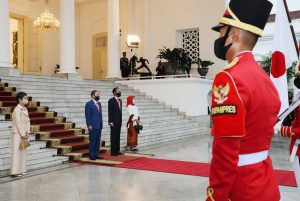This month, Japanese Prime Minister Suga Yoshihide selected Southeast Asia as the location for his maiden overseas visit since taking office in September, replicating the trip that his predecessor Abe Shinzo made back in 2013. Beyond the rationale for the voyage itself, the trip spotlighted the wider question of the extent of continuity and change in Japan’s approach to Southeast Asia under the aegis of its “free and open Indo-Pacific” policy.
As I have observed before, Southeast Asia has long played an important role in the evolution of Japan’s post-WWII foreign policy. In 1977, a speech that former premier Fukuda Takeo delivered in Manila outlined a Japanese vision of economic diplomacy that later become known as the Fukuda Doctrine. Japan further increased its role in Southeast Asia under Abe, from his conception of the “Indo-Pacific” to the spearheading of quality infrastructure in the economic domain and the brokering of the Vientiane Vision on the security side.
With Abe stepping down and Suga ascending to the premiership in September, observers were alert for signs of continuity and change with respect to Japan’s foreign policy in general, and its approach to Southeast Asia in particular. To be sure, certain realities – be they the convergence of major powers around the concept of the “Indo-Pacific” or Southeast Asia’s status as a testing ground for such issues as infrastructure standards and maritime law – did suggest that a certain amount of continuity would be evident. Nonetheless, given the range of variables, including Abe’s personal role in the advancement of Japan’s Indo-Pacific approach and the evolving domestic political dynamics in Japan, questions remained about the exact shape of Tokyo’s approach to the region.
Seen from that perspective, optics-wise, Suga’s ASEAN recent voyage was a reaffirmation that Southeast Asia continues to occupy a significant place in Japan’s foreign policy. Suga’s visit took him to both Indonesia and Vietnam, the former being the demographic heavyweight in Southeast Asia and the latter holding the rotating chairmanship of the Association of Southeast Asian Nations (ASEAN). Suga’s engagements reflected this as well, from his advancement of defense ties with the two nations, a key feature of Japan’s engagement under Abe, to the reaffirmation of ASEAN’s wider role in the Indo-Pacific, which included an acknowledgment of the grouping’s own ASEAN Outlook on the Indo-Pacific.
However, the bigger questions about Japan’s role in Southeast Asia lie further down the road. With respect to Tokyo’s ties with the Southeast Asian states, Suga still has big shoes to fill in terms of advancing key relationships, whether it be making further advances on initial policy gains or simply clocking significant mileage in the region (Abe visited all ten ASEAN nations during his first year in office.) More broadly, as important as Southeast Asia might be, how Japan makes deals with its relations with powers like China and the United States (especially after the U.S. election next week) will also affect the shape of its ties with the subregion and the Indo-Pacific region more broadly.
Meanwhile, at home, although Suga offers continuity in Japan’s approach to the world for now, the longer-term question is how Japanese politics will shape up after the country holds its next election in 2021. Though history may not necessarily repeat itself, there will no doubt be lingering anxieties about whether Japanese domestic politics may limit to some degree its ability to engage abroad, including the possibility that it could revert to the pattern of “revolving door” prime ministers that characterized the years leading up to Abe’s second term, the longest single period that any Japanese prime minister has spent in office.
Of course, this is not to dismiss the importance of Suga’s ASEAN voyage or its significance for Japan’s relations with Southeast Asia. But it does mean that despite the indications thus far, ASEAN countries will be watching carefully to assess how Japan engages them and what that means for their own interests as well as the shape of the regional and international order as a whole.

































